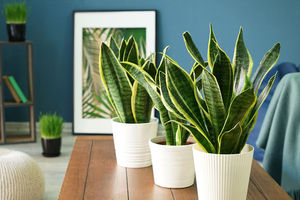
Some plants are key in removing formaldehyde, a toxin that are found in items such as carpets and curtains. PHOTOs/unsplash.com.
According to research by the Environmental Protection Agency (EPA), indoor air is typically two to five times more polluted than outdoor air. Therefore, it is crucial to maintain clean indoor air, especially considering that we spend a significant amount of time indoors. Many homeowners have taken the initiative to integrate outdoor features such as living plants into their indoor spaces. Indoor plants not only enhance the aesthetic appeal of your home by adding instant colour and texture but also offer numerous health benefits, such as air purification.
Here are some of the best indoor plant options that contribute to a healthier indoor environment by filtering out common pollutants.
Spider plant
The spider plant also known as the ribbon plant is one of the easiest plants to grow as it thrives in conditions of indirect sunlight, and moderate watering and even tolerates neglect. It features long slender arching green leaves with a central yellow/white stripe. As the plant has the ability to ward off toxic compounds, the preliminary tests conducted by the National Aeronautic and Space administration, found that spider plants were able to remove 95 percent of toxic substances thus proving its effectiveness at removing indoor pollutants such as formaldehyde, xylene, and toluene from the air. It is also one of the best plants that remove carbon monoxide and other toxins.
Snake plant
Often referred to as mother-in-law’s tongue, the snake plant is renowned for its air-purifying abilities, effectively removing toxins such as formaldehyde, benzene, xylene, toluene, and trichloroethylene from the air. The snake plant features long, stiff, upright leaves that are typically dark green with light gray-green horizontal stripes and often have yellow edges.
Additionally, it is one of the few plants that convert carbon dioxide to oxygen at night. This oxygen-rich air is crucial for promoting a peaceful night’s sleep by enhancing oxygen flow to the brain. Despite requiring low maintenance, the snake plant is highly tolerant and can thrive under a wide range of conditions, including neglect. This makes it an excellent choice for beginners and individuals with busy lifestyles.
The peacock plant
It is also called Calathea makoyana and features large oval leaves with feather-like patterns resembling a peacock’s tail feathers, hence its name.
Although this plant requires a lot of care and attention to growing conditions, it is an air purifier that serves various roles: increasing oxygen concentration in the air, trapping dust, and effectively removing chemical vapors, thereby making your indoor space healthier.
Peace lily
It is a beautiful plant known for its elegant appearance, featuring glossy, dark green lance-shaped leaves and white flowers that add a touch of sophistication and tranquility to indoor spaces. The peace lily is highly effective at removing indoor air pollutants such as ammonia, carbon monoxide, and trichloroethylene. According to NASA, it can also remove fumes such as cigarette smoke, paint, and furniture fumes from the ambient air.
Peace lilies absorb harmful mold spores and have been shown to improve air quality by up to 60 percent. Although these plants can thrive in bright indirect sunlight, they can also tolerate low light conditions. Importantly, the peace lily is mildly toxic if ingested due to its calcium oxalate crystals, which can irritate the mouth and digestive tract. Therefore, keeping the plant out of reach of pets and children is crucial.
The bamboo palm
The bamboo palm, also known as the Reed Palm, has slender cane-like stems resembling bamboo, hence its name. Its lush, tropical appearance and elegant fronds make it a beautiful addition to any indoor space, adding a touch of greenery and sophistication.
Known for adding humidity to dry indoor environments, the bamboo palm is also effective at removing indoor air pollutants such as formaldehyde (found in facial tissues, paper bags, and towels) and xylene (from rubber, leather, and paint). Occasionally, the reed palm may attract spider mites, mealy bugs, or scale, requiring regular inspection and treatment to prevent infestations.
Rubber plant
The rubber plant has large thick oval-shaped leaves that are dark green and shiny. It serves several health benefits from removing indoor air pollutants such as formaldehyde to increasing humidity in the indoor environment by restoring moisture in air to removing mold and any bacteria by as much as 50 percent. The plant is also key in absorbing exhaled carbon dioxide and mixing it with hydrogen to create oxygen that purifies air.
Golden Pothos
It is commonly known as Devil’s Ivy. The versatile plant features green heart-shaped glossy leaves with yellow or cream variegation and can be displayed in hanging baskets or shelves and this helps add appeal to space.
This plant thrives in areas with low-light conditions and adequate water and studies by NASA have proved its efficacy in reducing formaldehyde, benzene and toluene thus cleaning indoor air from toxins.
The Boston fern
Boston fern has long arching fronds that are composed of numerous small leaflets, giving it a delicate, feathery appearance. This plant requires moisture and humidity to thrive and according to Dr. Bill Wolverton an environmental scientist, Boston ferns are key in removing formaldehyde, a toxin that are found in items such as carpets and curtains.
They also help to increase humidity, which can be beneficial for the indoor environment. Due to their elegant touch, Boston ferns are especially popular for hanging baskets and as focal points in room decor.
English ivy
The English ivy is an attractive houseplant known for its trailing vines with dark green lobed leaves that are usually with prominent veins. It is one of the most effective houseplants that filter airborne mold particles that can be found in areas such as bathrooms with studies suggesting it filters 78 percent of airborne mold in 12 hours. It also helps clean toxins such as benzene from the air.




